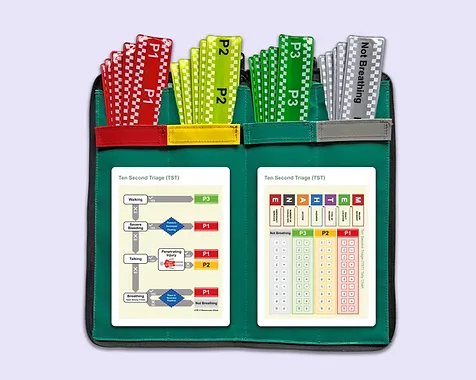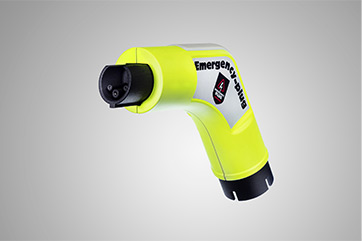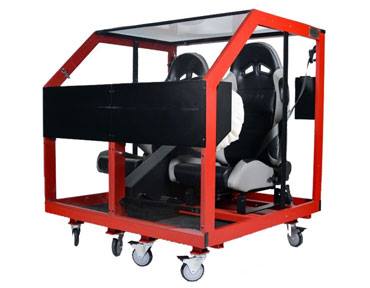Welcome to the products page, below we list products that can be used in training or during every day service. If you would like your product to be featured in Rescue-Sim please contact us.
Ten Second Triage Tool

The Ten Second Triage tool (TST) is intended to be used by anyone responding to a major incident to provide care to casualties prior to the arrival of the NHS clinical response. Once a casualty has been triaged it is important to ensure that the assigned priority is communicated to further responders to ensure casualties are dealt with in the order of priority and avoid duplication of effort, ultimately helping to save more lives.
As part of the TST process, simple but consistent labelling that indicates the priority of the casualty must now be used to communicate to further responders and ensure resources are directed appropriately. NHS England has provided a specification for colour-coded triage bands that corresponds to the triage category colour, there are four in total.
Metafont Ltd is a UK-based design and print company that is now already supplying these triage bands to the emergency services, each conforming to correct NHSE specifications. The products have a steel memory metal core encased within low light fluorescent reflective coloured material (made of PVC and latex free). The bands are flexible so they wrap around a limb (wrist usually) so they can be pulled straight but snap around a limb if ‘slapped’ against the limb and can then be straightened again and reused multiple times if required.
Vehicle Fire Blanket
Electric Vehicles are increasing in popularity, and a vehicle fire blanket can be your first line of defence when any type of vehicle shows signs of potential danger. Often the option of leaving the vehicle to set alight and burn is not possible, especially if the vehicle is situated within underground parking, multi-storey car parks, on a ferry, or located in an area surrounded by the public or workers.
The vehicle fire blanket can provide additional time to evacuate the area and give emergency services enough time to arrive and prepare for the emergency, preventing a fire that would be devastating to the surrounding area.
By purchasing a Vehicle Fire Blanket from Rescue-Sim you will receive free access to all our Training Modules which includes the Fire Blanket training module, enabling you to ensure your team are trained and prepared to deploy the blanket.

Emergency Plug
An electric or plug-in vehicle will not turn off if you release the clutch, and you cannot hear the engine running. This is in contrast to a fuel car. The motor only switches off when it is a High impact collision, provided the safety systems works. First responders cannot determine whether the ‘High Impact effect or kenetic energy’ was sufficient and whether the safety systems actually did work. Moreover, the technology of an electric car is already so advanced that the engine is switched on when the driver takes place in the driver's seat. Often no key or button is needed to turn it on and off. In this situation it is impossible for the first responder to anticipate this.
The casualty may unknowingly or consciously press the accelerator pedal while the vehicle is still running. The car will respond immediately, and no person will hear this. Because an electrically powered vehicle has an enormous torque, it is almost impossible to lock the wheels. In fact, the situation is only getting more dangerous, the blocking acts like a ski jump. There is therefore a very high chance that an undesirable situation will arise for the first responder, the casualty and bystanders; there is a high risk of serious injuries and even death.
The Emergency responders who arrive on scene first, places the Emergency plug in the charging connection of the vehicle. The plug makes the car's software think that the car is charging. In every car worldwide, software is regulated that when a car is charging, it may not be able to drive away. Every manufacturer had to build in the same protocol to prevent serious damage to charging stations and the electricity grid.
The Emergency plug is equipped with two different plug types (type 1 & type 2). With this one plug you can therefore block all types of plug-in cars against driving away. Using the Emergency-plus is very easy to handle that no training is required.

SimRescue
Simulate patient removal from a motor vehicle accident with SimRescue The Auto Extrication System! This training system allows instructors to simulate real-life calls in their very own classroom. Traditional classroom vehicle extraction demonstrations typically include a chair or a junkyard automobile to simulate a motor vehicle accident and are far from ideal for students tasked with learning life-saving techniques. With the SimRescue Auto Extrication Training System instructors can quickly setup a variety of extrication scenarios to allow students to train using real-life limitations of a compromised vehicle while the entire class observes the techniques being performed.
The SimRescue Auto Extrication Training system was created to provide EMS instructors with the tools to properly train their students on vehicle extraction. This training system is roughly the size of an actual automobile interior but can separate into smaller sections so it can fit through classroom doors with ease! The frame is built with high quality steel and Lexan covering to ensure the system can be used for years without any damage and can be easily transported to different classroom or simulation settings.

Bumper to Bumper Extrication Publication
The automotive industry is relentless in its pursuit of occupant safety in the vehicles they produce. Firefighters and rescue personnel need to continually update their knowledge on all aspects of vehicle technology. This presentation takes the new out of new vehicle technology and presents leading-edge information in a relevant manner that removes any previously learned scare tactics in other classes. Students will walk through vehicle design and construction from bumper to bumper highlighting changes in technology, materials, and processes. In addition to where the technology is found in vehicles, the why and how is briefly covered to make the student a better responder and improve patient outcome. Learning Objectives: Firefighters will read with an awareness/operations level of safety standards, body structures, seat structures, airbags, seatbelts, electric vehicles, 12-volt battery locations, where and why more laminated glass is being used, and how stabilization is affected with hybrid and electric vehicles.
With all of the different new vehicle technology information currently floating around the fire service, a down and dirty awareness level seem to be missing. The book provides a bumper-to-bumper awareness/operations level approach to new vehicle technology that any level of experience can immediately use on the job and even pass the information on to their departments and co-workers. The extrication discipline is flooded with new vehicle technology classes. This presentation incorporates my fire service experience and blends the knowledge from inside the auto industry into a street-level approach. My experience is a hybrid mix of automotive engineering and fire service background. I work in the auto industry in Detroit, Michigan with nearly 3 decades of experience in design and engineering. During my career, I worked on vehicle structures, and interior trim, and the last 15 years of extensive experience with seat systems for two of the largest seat suppliers in the world. The seat system experience includes safety systems, airbags, mechanisms, and seat structures

Rosenbauer Battery Extinguishing System
Facing an electric vehicle fire in your community is not a matter of if, but when. Rosenbauer has the safest, most efficient way to respond to this call when it comes. The Rosenbauer Battery Extinguishing System Technology (BEST) is the most advanced system available on the market with six years of research and development, and real-world application testing with automotive partners and fire departments.
• To learn more about the operation of the BEST, watch this video
• To learn more about electric vehicle battery fires, watch this video
• Fast – Simple operation and setup can be achieved in less than 2 minutes; deployment of the piercing nozzle happens in 8 milliseconds gaining internal access to effectively cool all battery pack designs.
• Efficient – Bringing water exactly where it is needed to effectively cool the battery pack, modules, and cells from within. The ability to halt a thermal runaway battery pack fire in as little as 10 minutes, flowing at a mere 8 gal/min at 100 PSI, far less than using the current EV manufacturer safety data sheets advising a minimum of 8,000 gallons of water to achieve the same results.
• Safe – The field-proven design keeps the operator 26’ from the involved EV while operating the BEST, limiting exposure to heat and highly toxic fumes released from a lithium-ion battery fire.

Demobus
The mobile simulator was born from Gabriel Fontanari's own idea, since it is practically impossible to obtain truck cabins for training rescue techniques.
COPICK:
The Copick is designed for 5 people and has two beds, a toilet with shower, a kitchen and air conditioning to provide the traveling teachers with the necessary comfort.
FEATURES:
In the simulator you can train 24 firefighters at the same time, divided into 4 groups.
It works with 2 instructors teaching the basic level, where only 50% of the unit is used.
To teach the advanced level and reach 90% of the simulator demonstrations, 4 instructors are needed.
THEMES OF THE CABINS:
Car No. 1 Represents a rear-end collision with separated vehicles on the driver's side. Maneuvers: stabilization, release of doors, cutting of fuses and frontal displacement of the dashboard. On the passenger side: stabilization, door deployment, and floor flipping to free the victim. In addition, third access points can be created from the rear of the cab for 0-degree extractions.
Cab No. 2 Represents a total overturn of a truck, and the maneuvers are as follows: On the passenger side: stabilization, opening of the base, blasting of the door and creation of a third access to free the victims. The driver's side is the same as above, but with some variations.
© 2007-2024 Total Programme Control Ltd.
